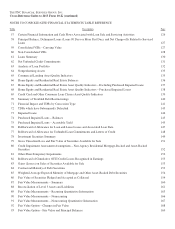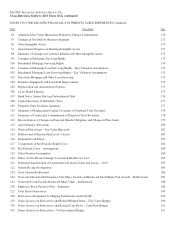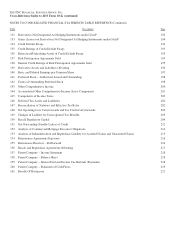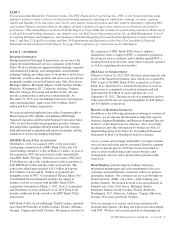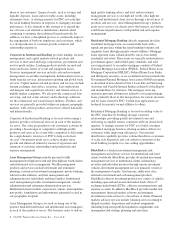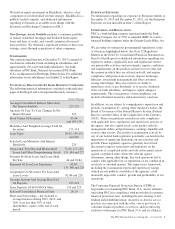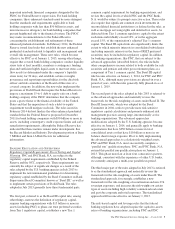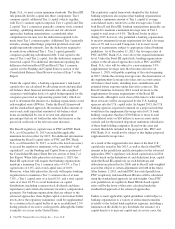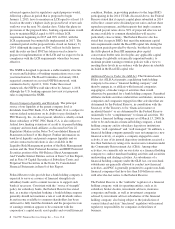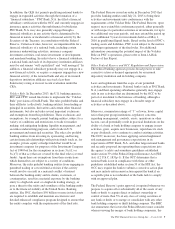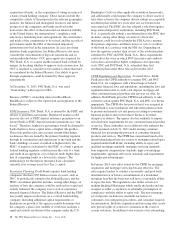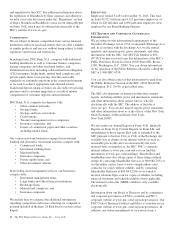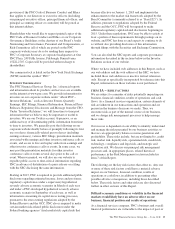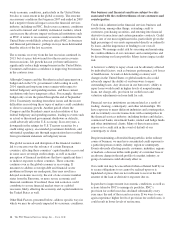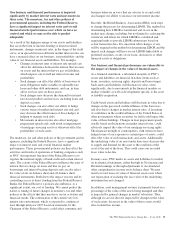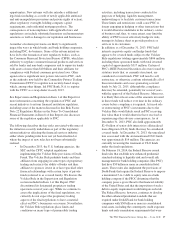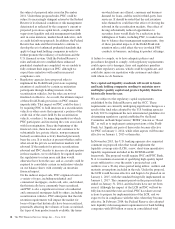PNC Bank 2013 Annual Report Download - page 26
Download and view the complete annual report
Please find page 26 of the 2013 PNC Bank annual report below. You can navigate through the pages in the report by either clicking on the pages listed below, or by using the keyword search tool below to find specific information within the annual report.
advanced approaches for regulatory capital purposes would,
following a phase-in period that is proposed to begin
January 1, 2015, have to maintain an LCR equal to at least 1.0
based on the entity’s highest daily projected level of net cash
outflows over the next 30 calendar days. Under the phase-in
provisions of the proposed rules, banking organizations would
have to maintain HQLA equal to 80% of their LCR
requirement beginning in 2015 and 90% in 2016, with the
LCR requirement becoming fully implemented in 2017. The
comment period on the proposed rules closed on January 31,
2014. Although the impact on PNC will not be fully known
until the rules are final, PNC has taken several actions to
prepare for implementation of the LCR and we expect to be in
compliance with the LCR requirements when they become
effective.
The NSFR is designed to promote a stable maturity structure
of assets and liabilities of banking organizations over a one-
year time horizon. The Basel Committee, in January 2014,
requested comment on a revised NSFR framework, with
comments due by April 11, 2014. Under the revised
framework, the NSFR would take effect by January 1, 2018,
although the U.S. banking agencies have not yet proposed
rules to implement the NSFR.
Parent Company Liquidity and Dividends. The principal
source of our liquidity at the parent company level is
dividends from PNC Bank, N.A. PNC Bank, N.A. is subject to
various federal restrictions on its ability to pay dividends to
PNC Bancorp, Inc., its direct parent, which is a wholly-owned
direct subsidiary of PNC. PNC Bank, N.A. is also subject to
federal laws limiting extensions of credit to its parent holding
company and non-bank affiliates as discussed in Note 22
Regulatory Matters in the Notes To Consolidated Financial
Statements in Item 8 of this Report. Further information on
bank level liquidity and parent company liquidity and on
certain contractual restrictions is also available in the
Liquidity Risk Management portion of the Risk Management
section and the Trust Preferred Securities and REIT Preferred
Securities portion of the Off-Balance Sheet Arrangements
And Variable Interest Entities section of Item 7 of this Report,
and in Note 14 Capital Securities of Subsidiary Trusts and
Perpetual Trust Securities in the Notes To Consolidated
Financial Statements in Item 8 of this Report.
Federal Reserve rules provide that a bank holding company is
expected to serve as a source of financial strength to its
subsidiary banks and to commit resources to support such
banks if necessary. Consistent with the “source of strength”
policy for subsidiary banks, the Federal Reserve has stated
that, as a matter of prudent banking, a bank holding company
generally should not maintain a rate of cash dividends unless
its net income available to common shareholders has been
sufficient to fully fund the dividends and the prospective rate
of earnings retention appears to be consistent with the
corporation’s capital needs, asset quality and overall financial
condition. Further, in providing guidance to the large BHCs
participating in the 2014 CCAR, discussed above, the Federal
Reserve stated that it expects capital plans submitted in 2014
will reflect conservative dividend payout ratios and net share
repurchase programs, and that requests that imply common
dividend payout ratios above 30% of projected after-tax net
income available to common shareholders will receive
particularly close scrutiny. The Federal Reserve also has
stated that it expects BHCs that meet the minimum capital
ratio requirements under the Basel III capital rule during the
transition periods provided by the rule, but that do not meet
the fully-phased in Basel III minimum plus capital
conservation buffer ratio levels (plus any applicable capital
surcharge for globally systemically important banks), to
maintain prudent earnings retention policies with a view to
meeting these levels in accordance with the phase-in schedule
included in the Basel III capital rule.
Additional Powers Under the GLB Act. The Gramm-Leach-
Bliley Act (GLB Act) permits a qualifying bank holding
company to become a “financial holding company” and
thereby engage in, or affiliate with financial companies
engaging in, a broader range of activities than would
otherwise be permitted for a bank holding company. Permitted
affiliates include securities underwriters and dealers, insurance
companies and companies engaged in other activities that are
determined by the Federal Reserve, in consultation with the
Secretary of the Treasury, to be “financial in nature or
incidental thereto” or are determined by the Federal Reserve
unilaterally to be “complementary” to financial activities. We
became a financial holding company as of March 13, 2000. In
order to be and remain a financial holding company, a bank
holding company and its subsidiary depository institutions
must be “well capitalized” and “well managed.” In addition, a
financial holding company generally may not engage in a new
financial activity, or acquire a company engaged in a new
activity, if any of its insured depository institutions received a
less than Satisfactory rating at its most recent evaluation under
the Community Reinvestment Act (CRA). Among other
activities, we currently rely on our status as a financial holding
company to conduct merchant banking activities and securities
underwriting and dealing activities. As subsidiaries of a
financial holding company under the GLB Act, our non-bank
subsidiaries are generally allowed to conduct new financial
activities, and PNC is generally permitted to acquire non-bank
financial companies that have less than $10 billion in assets,
with after-the-fact notice to the Federal Reserve.
The Federal Reserve is the “umbrella” regulator of a financial
holding company, with its operating entities, such as its
subsidiary broker-dealers, investment advisers, insurance
companies and banks, as well as investment companies
advised by investment adviser subsidiaries of the financial
holding company, also being subject to the jurisdiction of
various federal and state “functional” regulators with normal
regulatory responsibility for companies in their lines of
business.
8The PNC Financial Services Group, Inc. – Form 10-K


